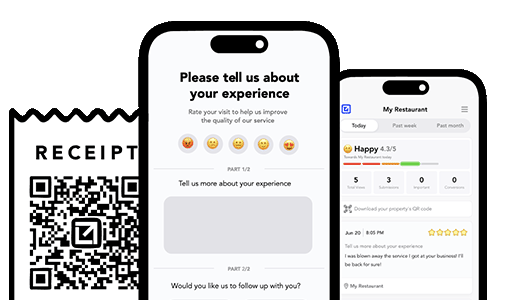Restaurant Marketing in 2025 [Guide]
How to market a restaurant in 2025 using modern strategies and tools.

TLDR: In 2025, generic email blasts don’t cut it, especially in the restaurant space. If you want real results, you need emails that are personal, timely, and rooted in what guests actually care about. This guide walks through how to use personalized email offers to increase guest loyalty, drive repeat visits, and improve long-term retention. You’ll learn how to collect meaningful guest data (without being creepy), segment your list based on behavior and feedback, and deliver emails that feel like a one-on-one experience. We’ll also explain how tools like VisibleFeedback can help you trigger smarter emails by capturing private feedback and turning it into tailored outreach. Whether you’re a cozy cafe or a high-volume bistro, personalized email is one of your most underused levers for growth.
Too many restaurants treat email like a megaphone. “This week’s specials.” “Happy Hour extended.” “New menu drop.” These get ignored, not because your customers don’t care, but because they don’t feel seen.
Personalized email changes that.
Imagine opening an email that says:
“We saved your favorite dish (and a free dessert) for your next visit.”
Or:
“It’s your third visit this month, your next appetizer’s on us.”
These messages don’t just inform, they reward, recognize, and remind customers why they love your restaurant. That’s the kind of email that gets opened, clicked, and remembered.
Personalized offers aren’t about creepy data mining or one-to-one automation. They’re about relevance. When a guest feels like an email was meant for them, not just “someone on your list”, they’re far more likely to act on it.
Benefits include:
It’s one of the few marketing channels where you don’t have to fight for attention, you already have it. Now you just have to use it well.
Here are the best-performing types of personalized email offers you can send:
Based on past orders or private feedback:
These emails work because they’re tied to something real. They’re not guesses. They’re responses.
You don’t need invasive tracking to personalize email. You just need simple guest signals:
VisibleFeedback captures all this, then helps you tag guests by experience type, sentiment, and behavior. That means you can segment your list without hiring a CRM analyst.
Once you have guest signals coming in, here’s how to use them:
Tools like VisibleFeedback make this easier by linking feedback to email tools, so you can automate the follow-up based on real context, not just guesswork.
If you’re new to this, start with a small test:
“Thanks for your kind words, next appetizer’s on us. Just show this email.”
Track who clicks. Track who returns. You’ll be surprised how well it works.
When you walk by a table and recognize someone, that interaction builds loyalty. Personalized email is your chance to do that, at scale.
In a world full of noise, the restaurants that win in 2025 are the ones that listen, respond, and connect.
Use email to do that. Use feedback to guide it. Use tools like VisibleFeedback to automate it.
Because when your guests feel like you remember them, they’ll remember you.

Bad reviews can scare away potential customers. Intercept feedback in real time with VisibleFeedback.

Austin Spaeth is the founder of VisibleFeedback, a simple tool that helps brick-and-mortar businesses intercept negative reviews before they go public. With a background in software development and a passion for improving customer experience, Austin built VisibleFeedback to give business owners a frictionless way to collect private feedback and turn unhappy visitors into loyal advocates. When he’s not working on new features or writing about reputation strategy, he’s probably wrangling one of his six kids or sneaking in a beach day.
Whether you have no reviews, bad ones, or great ones, we’ll help you turn your feedback into growth.
No credit card required.
⛨ Trusted by over 137 local businesses like yours